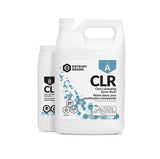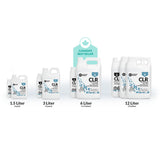Description



Product Description
Entropy Resins’ SUPER SAP® CLR Clear Laminating Epoxy is our flagship, high-performance clear coating epoxy resin system. The CLR system is a water clear, UV stabilized epoxy system for applications that require a low colour, low yellowing epoxy resin such as high colour applications. This system features a quick air-release and world-class UV resistance package. SUPER SAP® CLR works with multiple hardeners to match your working parameters. It has an ideal viscosity for a wide range of applications that use hand layup techniques with fast room temperature cures.
Available in EXTRA FAST (CLX Extra Fast Hardener), FAST (CLF Clear Fast Hardener), and SLOW (CLS Clear Slow Hardener) cure speeds. Hardener speeds can be combined to custom working times.
Extra Fast Cure: 18 min pot life, 2 HR tack-free time.
Fast Cure: 21 min pot life, 4 HR tack-free time.
Slow Cure: 43 min pot life, 8 HR tack-free time.
2 Part Epoxy Kits are comprised of:
Super Sap CLR Epoxy Resin and
CLX (EXTRA FAST) or CLF (FAST) or CLS (SLOW) Hardener
For white substrate applications, we recommend our BRT formula.
Best Uses
Our partner Entropy Resins’ coating and laminating epoxies are SUPER SAP® Formulations. Designed for versatility, they can be used in a wide range of applications, from laminating fiber-reinforced composites to thin film coatings. Featuring simple 2:1 mix ratios and a variety of cure speeds, they are engineered for ease of use. Superior strength, excellent adhesion to many surfaces, industry-leading clarity, and UV epoxy stability make these epoxies the right choice for coating and laminating projects.
- Brush On Clear Coatings
- Structural Adhesives
- Adhesives and sealants
- Fiber reinforced composites
- Fiberglass composites
- Carbon fiber composites
- Natural fiber composites
- Fiberglass boat repair
- Surfboards, standup paddle boards, handplanes
Instructions
Application Tips
- For best results, measure the two components by weight within 5% of the recommended mix ratio.
- Always mix the product for at least two minutes, scraping the container to ensure complete mixing.
- Use products in a controlled environment. Avoid high humidity and cold temperatures.
- Amine blush, a by-product of the curing process, appears as a wax-like film cured epoxy and is more noticeable in cool, moist conditions. It can clog sandpaper and inhibit subsequent bonding. Blush is water-soluble and easily removed with clean water (not solvent) and an abrasive pad.
- For good adhesion, epoxy bonding surfaces should be clean, dry, and sanded.
- If you are unfamiliar with the product, create small test samples before starting a larger scale project.
General Surf Coverage Guide
- 1 Shortboard 6 Ft or 2/m – 3 Liters of Mixed Epoxy and Hardener
- 1 Sup or 2 Longboards – 12 Liters of Mixed Epoxy and Hardener

Technical & Safety Data
English Technical & Safety Data
Resin FAQ
For questions and technical advice call our helpline,
staffed by Composite Material Engineers
310-882-2120
We also have some great tips and tricks on our
Entropy Resins Care and Handling instructions page
Online orders ship to anywhere in Canada by 5-7 days.
If you have questions about stock or shipping, email or call us.
More often than not, you can use heat to troubleshoot issues with resin. Read more about how to save crystallized resin here.
Although our room temp cure systems are designed not to need a post-cure, all epoxies benefit from the addition of heat as a post-cure. Read more about why post-curing is important here.
CCR resin states it’s “water clear”, which is a reference to opacity, not "colour". That means our resin is as transparent as water, but it might have a slightly red hue.
It’s important to note that a water clear resin can impart a subtle colour over the substrate. In the case of white surfboards, you wouldn’t want any colour, so water clear may not be the best choice. However, in the case of certain wooden substrates, sometimes a bit of colour is desirable. For example, many users believe their wood looks richer after they apply ONE.
Unfortunately, there is no such thing as a resin with NO VOCs. In fact, all epoxies, resins, and polyesters emit VOCs. Read more about VOCs here.
(BC) Bio-Content is the term used to describe the level of biobased content in Entropy Resins before they are mixed with a hardener. Resin has a higher bio-content than hardener so the ratio goes down once mixed.
(MBBC) Mixed Biobased Carbon Content is the term used to describe the level of biobased content in Entropy Resins once you have mixed resin with the hardener.
Read about these two terms and our commitment to carrying more environmentally responsible products.
Entropy Resins’ Super Sap Technology replaces perto-chemical with renewable, biobased material. Entropy Resins’ is better for the planet but, we do not recommend eating directly from epoxy resin materials.
In order for epoxy (or any material for that matter) to be recommended for food contact it must be certified by the FDA. Entropy Resins is not FDA certified so we can't recommend use for food contact applications.
However when used properly Entropy Resins’ products are inert and it is possible to have your end product certified for food safety and contact. NSF certification is one such example and we've had customers' end product certified for food based applications though that method.
We used to ship 5-gallon jugs but have found that the 1-gallon jug is a better solution. Read about why we chose 1-gallon jugs here.
For live edge resins, choose CCR with CCF for pours 1” and under. Or else opt for CCR with CCS for pours 1” and over.
Please email or call and will set you up with a manufacturer's account.
Please email or call and will set you up with a wholesale account.








